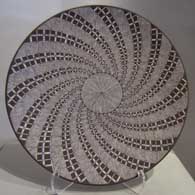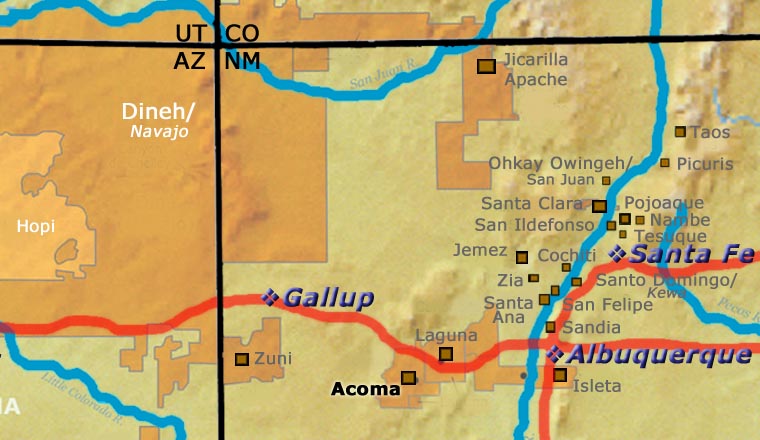
Rebecca Lucario
Acoma


Born at Acoma Pueblo in 1951, Rebecca Lucario is a member of the Yellow Corn Clan. She has been actively making pottery since 1965 and is recognized as the finest Acoma potter working today with her exquisite fine line eye dazzlers and Mimbres-Revival designs. Her pottery is thin and elegant, her designs perfectly executed.
Rebecca learned this art growing up with her sisters: Diane Lewis, Judy Lewis, Marilyn Ray and Carolyn Concho, and she's passing her knowledge on to her children. She says the ancient pottery-making techniques were passed to her from her maternal grandmother, Delores S. Sanchez (1902-1991). "My grandmother let me play with the mud they used to plaster their adobe house," she recalls. "We made little animal figures and pinch pots with red adobe clay. I still have two pots that I made when I was eight. One is a flower plate, the other a vase with fine lines. She never let us play with her clay because clay for making pottery is very sacred."
In Rebecca's process, she fires her pieces twice: first in an electric kiln to test the clay, then outside in the traditional manner. She says the traditional way gets much hotter than the kiln firing.
Her designs are so detailed and her lines so fine, she may spend up to 12 hours spread over several days just on the black design work for one of her pots. She says she doesn't measure or plot her designs with tools, she spaces the basic design elements purely by eye. She uses a traditional yucca brush to paint her designs and signs her creations: Acoma, NM R. Lucario, next to her kokopelli-playing-his-flute hallmark.
She told us the most difficult pieces of pottery to make are plates (they tend to buckle, warp or crack while drying and when fired). Rebecca has been known to make plates up to 30 inches in diameter. She explains, "The secret to making plates is to not make them too thin or too thick. You also have to knead the clay really well to get out any air bubbles it may have in it."
One of her amazing plates was featured on the cover of the 2002 catalog for the highly acclaimed Changing Hands: Art without Reservation touring exhibit organized by the Museum of Art & Design in New York City. She told us she gasped when she learned that the Museum created a giant banner of her plate and unfurled it at the opening of the exhibit. "That recognition kind of snuck up on me," she said.
Since 1983 Rebecca has been a consistent ribbon winner at the annual Santa Fe Indian Market with many First and Second Place ribbons in her collection.
Some of the Awards Rebecca has Won
- 2025 Heard Museum Guild Indian Art Fair & Market, Best of Show;
- Classification II - Pottery: Best of Class - 2019 Santa Fe Indian Market, Classification II - Pottery, Division B - Traditional Painted Pottery. Category 602 - Painted polychrome pottery in the style of Zuni, Acoma, Laguna, any form: Second Place
- Classification II - Pottery, Division F - Miniature pots, individual pieces under 3" in any direction, Category 1001 - Traditional: First Place - 2018 Santa Fe Indian Market, Classification II - Pottery, Division E - Contemporary Pottery, Any Form or Design, Using commercial clays/glazes, all firing techniques, Category 907 - Painted, any form: Honorable Mention
- 2017 Santa Fe Indian Market, Classification II - Pottery, Division E - Contemporary Pottery, any form or design, using commercial clays/glazes, all firing techniques, Category 905 - Miscellaneous: First Place
- 2004 Santa Fe Indian Market, Classification II - Pottery, Division E - Traditional pottery, jars, including wedding jars, Category 1202 - Jars, Acoma: First Place
- Classification II - Pottery, Division F - Traditional pottery, painted designs on matte or semi-matte surface, all forms except jars, Category 1305 - Plates: Second Place
100 West San Francisco Street, Santa Fe, New Mexico 87501
(505) 986-1234 - www.andreafisherpottery.com - All Rights Reserved

Acoma Pueblo

Sky City
According to Acoma oral history, the sacred twins led their ancestors to "Aaku," a magical mesa composed mostly of white rock, and instructed those ancestors to make that mesa their home. Acoma Pueblo is called "Sky City" because of its position atop the mesa. Acoma is located about 60 miles west of Albuquerque.
According to some archaeologists, a large group of Keres-speaking people left the Chaco Canyon area in the late 900s. They headed south, around the west side of the Mount Taylor volcano and across the Rio San Jose to Aaku, where they merged into a pueblo of people already living there.
Acoma, Old Oraibi (at Hopi) and Taos all lay claim to being the oldest continuously inhabited community in the U.S. Those competing claims are hard to settle as each village can point to archaeological remnants close by to substantiate each village's claim. While the people of Acoma have an oral tradition that says they've been living in the same area for more than 2,000 years, some archaeologists feel more that the present pueblo was established near the end of the major migrations of the 1200s and 1300s. The location is essentially on the boundary between the Mimbres-Mogollon to the south and west, and Ancestral Puebloan cultures to the north and east. Each of those cultures has had an impact on the styles and designs of Acoma pottery, especially since modern potters have been getting the inspiration for many of their designs from ancient potsherds they have found while walking on pueblo lands.
Francisco Vasquez de Coronado ascended the cliff to visit the Acomas in 1540. He afterward wrote that he "repented having gone up to the place." But the Spanish came back again, and kept coming back. In 1598 relations between the Spanish and the Acomas took a really bad turn with the arrival of Don Juan de Oñaté and the soldiers, settlers and Franciscan monks that accompanied him. After ascending to the mesa top, Oñaté decided to force the Acomas to swear loyalty to the King of Spain and to the Pope. When the Acomas realized what the Spanish meant by that, a group of Acoma warriors attacked a group of Spanish soldiers and killed 11 of them, including one of Oñaté's nephews.
Don Juan de Oñaté retaliated by attacking the pueblo, burning most of it and killing more than 600 people. Another 500 people were imprisoned by the Spanish: males between the ages of 12 and 25 were sold into slavery and 24 men over the age of 25 had their right foot amputated. Many of the women over the age of 12 were also forced into slavery and were eventually parceled out among Catholic convents in Mexico City. Two Hopi men also captured at Acoma had one hand cut off. Then they were released and sent home to spread the word about Spain's resolve to subjugate the inhabitants of Nuevo Mexico.
When word of the massacre and the punishments meted out got back to King Philip in Spain, he banished Don Juan de Oñaté from Nuevo Mexico. Some Acomas had escaped that fateful Spanish attack and returned to the mesa top in 1599 to begin rebuilding. In 1620 a Royal Decree was issued establishing civil offices in each pueblo, and Acoma had its first governor appointed. Those governors met at Santo Domingo Pueblo at the All Pueblos Council, the first democratic institution in the Americas, an institution that is still functioning.
By 1680, the situation between the pueblos and the Spanish had deteriorated to the point where the Acomas were extremely willing participants in the 1680 Pueblo Revolt. After the successful Pueblo Revolt, the Spanish retreated to Mexico. Refugees from other pueblos began arriving at Acoma, fearing an eventual Spanish return and reprisals. That strained the resources of Acoma until the Spanish actually did return. Then residents of the pueblo had to make a difficult decision. Many of the refugees chose to try a peaceful solution: they relocated to the ancient Laguna area and made peace with the Spanish as soon as they appeared in the region. Acoma made peace with the Spanish soon after.
Over the next 200 years, Acoma suffered from outbreaks of smallpox and other European-introduced diseases to which they had no natural immunity. They also sided with the Spanish against raiders from the Navajo and Apache tribes. Then New Mexico changed hands a couple times, the railroads arrived and, like every other Native American pueblo, the Acoma people became dependent on inexpensive goods brought in from the outside world.
For many years the villagers were content on the mesa top and they kept advances in technology below. Now most live in villages on the valley floor where water, electricity, natural gas and other "luxuries" are easily available. While a few families still make their permanent home on the mesa top, the old pueblo is used almost exclusively for ceremonies and celebrations these days.
Historically, Acoma was known for large, thin-walled "ollas," jars used for storing food and water. With the arrival of the railroad and tourists in the 1880s, Acoma potters adapted the size, shapes and styles of their pots in order to appeal to the new buyers.
Up into the mid-1960s, most Acoma potters felt it was an inappropriate display of ego to sign their pots. Then Kenneth Chapman convinced Lucy Lewis, Jessie Garcia and Marie Z. Chino of the value of their signatures and they started signing their pieces. The 1960s is also a time when the primary Acoma white clay vein passed through a layer of widely distributed impurities, impurities that passed through the clay filtering process and showed up only during and after the firing. The problem was so bad it affected virtually every Acoma potter and every pot they made. Thankfully, by the late 1960s they had burrowed through that layer of clay and into a deeper layer that didn't have the problem.
100 West San Francisco Street, Santa Fe, New Mexico 87501
(505) 986-1234 - www.andreafisherpottery.com - All Rights Reserved

Delores Sanchez Family Tree
Disclaimer: This "family tree" is a best effort on our part to determine who the potters are in this family and arrange them in a generational order. The general information available is questionable so we have tried to show each of these diagrams to living members of each family to get their input and approval, too. This diagram is subject to change should we get better info.
- Delores Sandoval Sanchez (ca. 1888-1991) & Toribio Sanchez
- Marie S. Juanico (1937-2024)
- Delores Aragon (Juanico) (1969-)
- Katherine Lewis (1932-)
- Bernard Lewis (1957-) & Sharon Lewis (1959-)
- Eric Lewis (1978-)
- Carolyn Concho (1961-) & George Concho, Sr.
- Alisha Sanchez & Greg Concho
- Shaylene Chino & George Concho Jr.
- Alisha Sanchez & Greg Concho
- Diane Lewis (1959-)
- Judy Lewis (1966-)
- Rebecca Lucario(1951-)
- Amanda Lucario (1984-)
- Daniel Lucario (1969-)
- Marilyn Ray (1954-)
- Edward Lewis Jr. & Eva Concho
- Edward Lewis III
- Bernard Lewis (1957-) & Sharon Lewis (1959-)
- Ethel Shields (1926-) & Don Shields
- Charmae Shields Natseway (1958-) & Thomas Natseway (1953-)(Laguna)
- Chris Shields & Michelle Shields (1972-)
- Curtis Shields
- Isaac Shields
- Natasha Shields
- Jack Shields (c.1961-)
- Judy Shields (daughter-in-law)
- Verda Mae Shields (daughter-in-law)
Some of the above info is drawn from Southern Pueblo Pottery, 2000 Artist Biographies, by Gregory Schaaf, © 2002, Center for Indigenous Arts & Studies
Other info is derived from personal contacts with family members and through interminable searches of the Internet and cross-examination of the data found.
(505) 986-1234 - www.andreafisherpottery.com - All Rights Reserved


